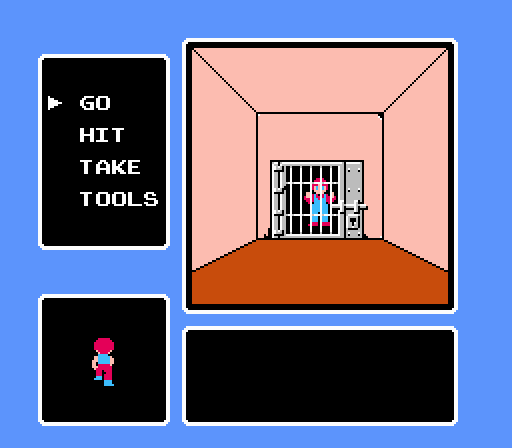
Well, alright. So you’ve rescued a Goonie. But that wasn’t a given by any means; The Goonies II nudges you in this direction, but it doesn’t strong arm you. There was another path you could have taken from here, and it goes rather far astray from Mouth or Chunk or whoever this kid’s supposed to be. In theory, this grumpy child could be the last Goonie you rescue. It’s a pretty open game, and with openness comes the potential for getting lost… though it should be said that going the other direction once you reach the cellar isn’t going the wrong way, exactly. It’s just not the most efficient use of your time.
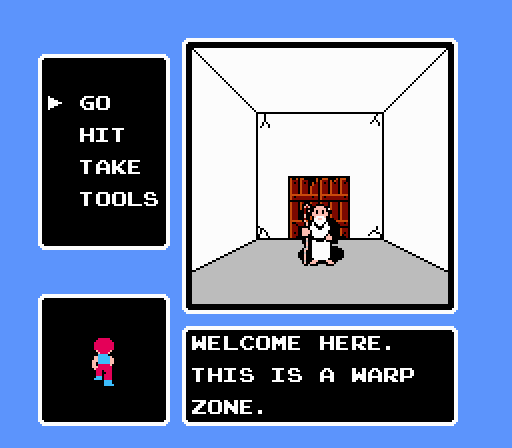
Should you wander over to this guy first instead of exploring the back side of the Fratelli restaurant, you’ll find yourself taking your first step into a much larger world. Sadly, you don’t inherit your father’s old lightsaber; dude’s a museum curator, after all. Instead, you move beyond the initial hideout and venture deep into a series of tropical caves.
The best way to explain the arrangement of the game map in The Goonies II is that it’s essentially stratified. There are multiple zones, but generally speaking these don’t sit side-by-side on the map. Instead, they sit one on top of the other, and a given zone usually stretches the width of a given chunk of the map. Basically these “chunks” each comprise about a quarter of the total map; both Front and Back maps are divided into an east and a west portion, and the only thing connecting east and west is a bridge that spans the middle on the Front map.
Occasionally you can move between two different zones by a ladder — for example, going from the restaurant to the cellar. And in all but a handful of cases, each zone exists (as palette swaps of a single graphical tile set) in the same approximate area on both Front and Back maps. You can pass between the Front and Back version of an area by passing through the Adventure scene that connects the two, but standard Adventure scenes only link up same type areas. To move between different area types — say, a cellar and a tropical cavern —you need to use a Warp Zone.
Again, it’s a slightly confusing world map arrangement, but The Goonies II does follow a certain consistent and orderly set of rules once you sort them out.
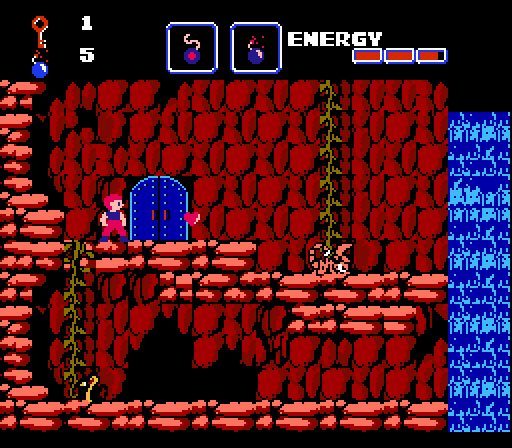
Anyway, this is the aforementioned “cellar to tropical cavern” Warp Zone. Ta-dah!
This earthy cavern feels like a major callback to the original Goonies. Rocks! Vines! Waterfalls that injure Mikey unless he’s wearing a rain coat! You really start to see how visually distinct this game is from its predecessor here, though. The enemies are completely different than the creatures you fought in the hideout and cellars, including giant scorpions that hit hard and can take a beating. There’s no more One-Eyed Willy, but this is kind of worse.
As in the restaurant cellar, you can elect to take a couple of different paths here. One of them leads you to the bridge that connects the two halves of the maps, though that leads to a dead end thanks to an insurmountable jump. And in any case, the door just to the left of where you arrive in the caverns takes you to yet another Warp Zone, which leads you to…
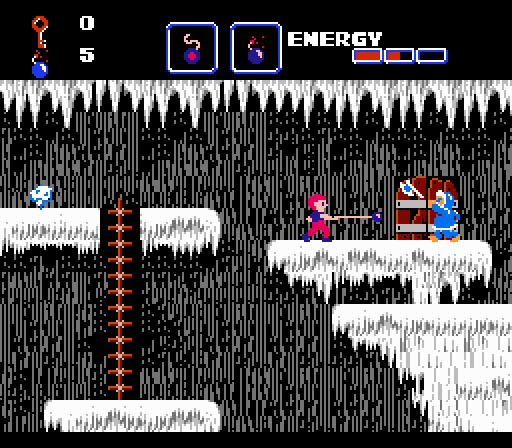
…some kind of bizarre ice cavern? Man. Astoria, Oregon has the weirdest geology. Though clearly this isn’t meant to be a natural formation given that it features polar bears and penguins and walruses and Eskimos, for some reason. These do not share a single habitat in nature!
The rapid transition from cellar to cavern to freezer feels too abrupt to be “right” — you’d think the game would give you a little more time in the waterfall area to get acclimated to the new environment — but in fact there’s a second trapped Goonie easily accessible here. Still, it’s a strange choice to make this the next immediate destination; your gaming instincts upon reaching the ice tell you to come back later. With falling stalactites and slippery footing, not to mention the rather aggressive native life, the ice cavern gives the impression of an advanced area. But it’s also quite small, one screen high and about three wide in total, and right away you’ll find one the lady Goonies to rescue.
There’s more to the freezer section than this, though. Like the other areas of the game, the ice caverns have a Front section and a Back section. Unusually, though, they’re not connected to one another directly. Instead, you need to pass between Front and Back in the waterfall caverns, then Warp to a corresponding section of ice caverns from there.
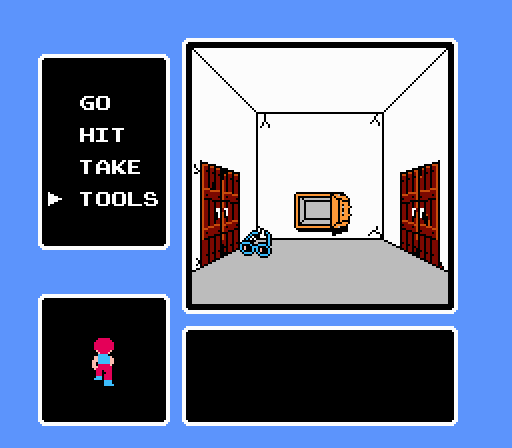
The second (Back) ice area is larger than the other section was by a modest amount, and it’s packed with essentials. It’s connected to the caverns by a pitch-black Adventure scene, though, which may serve as a deterrent to passing between map sides. There have been a few black rooms already, and while you can walk through them and fumble around blindly, it ultimately amounts to a guessing game that’s not particularly enjoyable.
You need the cache of goods from the second frozen cavern, though. Inside a hidden safe you’ll find a pair of glasses, an essential tool. And in the same Adventure scene, you can grab a Boomerang, a (semi-) permanent weapon selection that lets you hit enemies the length of the screen in eight different angles. It’s basically a slower version of the Metal Blade from Mega Man 2, which is to say, invaluable.
Unfortunately, this is also the point at which the game’s flaws begin to show through.
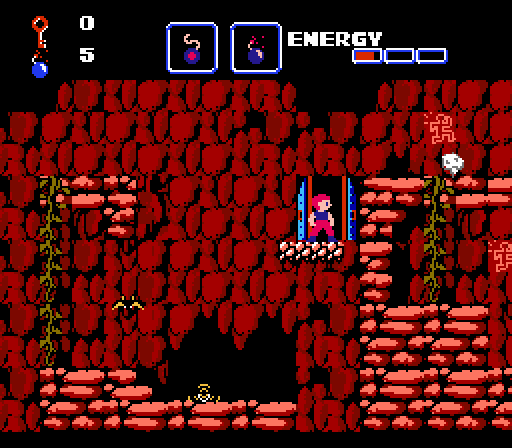
Konami’s designers still hadn’t quite gotten over their habits from the bad old days of hiding things in oblique ways. The Goonies II isn’t as bad as Simon’s Quest, but it still involves a lot of blind guesswork and trial-and-error. For instance, this door here is one of several in the game that only appears if you press up in an otherwise unremarkable area — a feature unfortunately carried over from the original Goonies. In itself it’s not a a totally unforgivable design choice (none of the hidden doors are utterly essential), but it introduces a maddening possibility space if you get stuck. Can’t find your way forward? Well, you reason, maybe the secret is hidden in a secret door, at which point you commence pressing up in front of every possible tile in the game.
The Goonies II breaks its own rules at times, too. In many of the Adventure scenes, you’ll meet NPCs who offer tips and help (the invisible door above, for example, is the home of Konamiman, who will refill your health for free). If you hit said NPCs, though, they’ll grow angry and refuse to talk to you. Except for the old lady living in the ice caverns — if you hit her five times, she’ll give you a candle to light the darkened Adventure scenes.
Perhaps most frustratingly, the Glasses (and another item you can find in this area, the Transceiver that allows you to gather hints from other characters remotely) demonstrate a strange quirk of the Adventure scene inventory system. Because of visual space limitations, Mikey’s inventory won’t fit into a single menu when you select “Tools.” There’s a second page that can be accessed by pressing the B button. The problem? At no point in the game or the manual does it tell you to press B to view that second page. Perhaps this is entirely an anecdotal complaint, but I found myself stuck for weeks in this game because I couldn’t figure out how to use the glasses I had collected. I didn’t think to press the B button because the manual literally says, “The B button is not used in Adventure scenes.” Even the Official Nintendo Player’s Guide, which I bought specifically for help getting through this game, didn’t explain the rules. Ultimately, I figured it out by mashing buttons in frustration. Always a sign of top-caliber interface design.

Oh well. You don’t need to understand how to use the Glasses to complete everything that’s possible in this area. Once you’ve combed the caverns and ice platforms, there’s nothing left to do but follow the Keith Haring graffiti to the daunting next area.
I am really tempted to start playing this game along with you to try and see if our opinions line up. I only played Goonies II once back when it came out and needed the Ultimate NES Players Guide to get through it. But I recall running into lots of “blindly searching around” when I hit apparent dead ends only to learn later that I didn’t know to hammer a wall or expose an obscure secret to proceed. I fear the “idea” of the game is much better than the actual game. I wonder why there aren’t any attempts to recreate the Goonies II experience but with the obscure bits left behind. And I don’t mean the indie attempts to make Metroidvania games, because they are more interested in their level layouts emulating these old games (and usually with less success) and not the mechanics. And by mechanics, I mean the items and the character controls.
Inspired by these articles, I played through the game again. It was surprisingly much more fun than I expected it to be, I feared it would be hard to navigate. As you say, the game has a weird set of internal rules that take a while to figure out, but once you learn them everything flows in an orderly manner.
For example, I found every item in my playthrough except the candle. Because the first person scenes have such a strict rule on what items can be used on what portions of the room, you develop a rhythm for finding secrets (Use hammer on all four sides and center, hit center, use glasses, use ladder, repeat). You learn what sounds and messages the game gives you when items are successfully used. Even without a candle, I was able to just bumble my way through.
Unfortunately, I never found the candle because I thought the game had a rule barring me from punching people and receiving aid. Silly me, I should have known that Goonies never stop punching women.
I honestly don’t know how I beat this game back then without any help whatsoever. And it was like my 10th finished game, so I was pretty new at gaming. I hadn’t even played Zelda, Metroid or any “getting lost” game back then. I know it took me several months because once I finished it I remember being excited and screaming at my brother and neighbor that I finally finished the game and feeling like I had spent years doing something.
As for that B button thing. I don’t remember having any issues with that back then. But I do remember getting stuck this time when I played the game again.